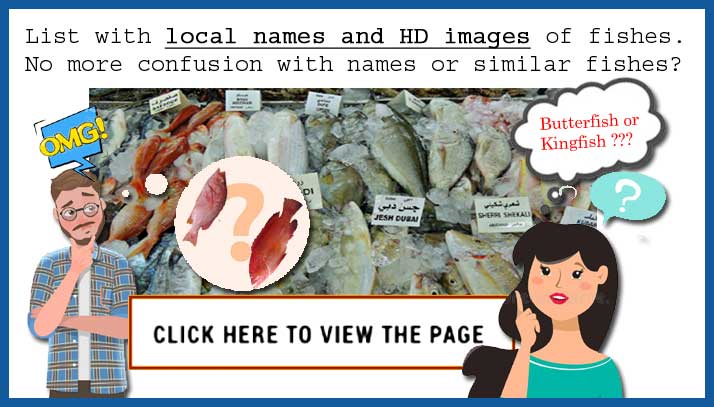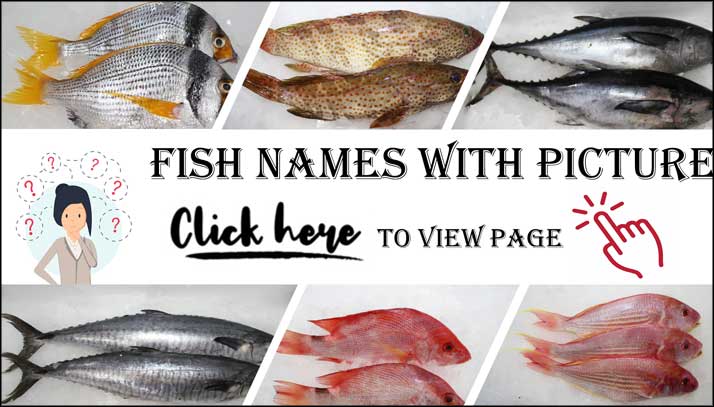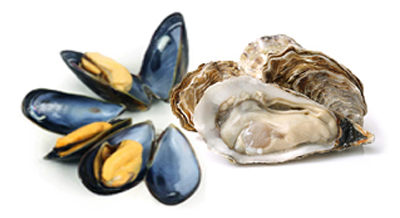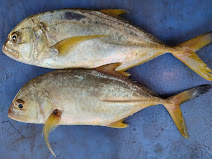| COMMON NAMES |
LOCAL NAMES |
தமிழ |
| Indian Spiny Loach |
Ayira meen
( It might be announced as a State fish of Tamilnadu, A delicacy in Madurai. A tamil nadu favourite , Rich in minerals and taste differs according to the soil ) |
அயிரை மீன் |
|
Anchovy / White bait
|
| Indian Anchovy |
Nethili |
|
| Golden anchovy / Gold spotted grenadier anchovy |
Thogai meen |
|
| Malabar anchovy |
Poruva |
|
| Dussumier’s anchovy |
Semporuva |
|
| Moustached anchovy |
Poruva/ Nedum poruva/ Kola |
|
| Commerson’s anchovy |
Nethali |
|
| Devis’ anchovy / Shorthand anchovy |
Nethili |
|
|
Barracuda
|
| Pick-handle barracuda / Banded barracuday |
Seela/ Kara ooli / Thiriyan |
|
| Great barracuda |
Seela/ ooli/ Thiriyan |
|
|
Barramundi / Sea perch / Seabass
|
| Giant sea perch/ Barramundi/ Sea bass / Sea Pike |
Koduva/ Painee meen |
|
| Waigen Sea Perch |
Chenganni |
|
| Crescent tiger Perch |
Keeli |
|
| Commerson’s glassy perchlet |
Selanthan |
|
| Jarbua terapon/ Crescent tiger perch |
Keechan/ Kovakeechan/ Keeli |
|
| Small-scaled terapon |
Pootankeeli/ Keechan |
|
| Indo Pacific terapon |
Menna |
|
|
Bulleye
|
| Moon-tail bulleye/ Dusky-finned bulleye |
Kakkasi |
|
| Glasseye/ Blood-coloured bulleye |
Kakkasi |
|
|
|
|
Crab
|
| Mud crab |
Pachai nandu/ Kazhi nandu |
|
| Blue swimming crab |
Olakkal nandu/ Pulli nandu |
|
| Three-spotted swimming crab |
Mukkannu nanadu/ Olakkal nandu |
|
| Christ shell crab |
Siluvai nandu |
|
|
Cobia
|
| Black kingfish/ Cobia |
Kadavara/ Kadal viral |
|
|
Dolphinfish
|
| Dolphinfish/ Mahi Mahi |
Parla, Avilis, Kal Vanna |
|
|
Clams/ mussel/ Oyster
|
| Green mussel |
Pachai aali/ Chippi/ Kallukka, Kallumakkaya |
|
| Brown mussel |
Aali/ Chippi/ Kallukka |
|
| Yellow clam |
Matti, Sippi, Mattikal |
|
| Blood clam |
Vari matti/ Ratha matti |
|
| Black clam |
Matti |
|
| Edible oyster |
Vella aali / Kavaddi |
|
| Pearl oyster |
Muthuchippi |
|
|
Carps
|
| Catla/ Thick lips |
Katla/Thoppa meen/ Japan kendai/ Koora kendai/ Yamaneri kendai/Karavai |
|
| Mrigal |
Mrigala/ Gudu kendai |
|
| Grass carp |
Pullu kendai |
|
| Common carp |
Carp |
|
| Rohu |
Rogu/ Kannadi kendai |
|
| Carnatic carp |
Palli kendai/ Sallkendai/ Sihelle/ Saal kendai/ Shellee/Pauvri-kendai |
|
| Climbing perch |
Sennal/ Panaiyerikendai |
|
|
Cichlids
|
| Green chromide/ Pearlspot |
Sethakendai/ Palincha/ Karassar / Karimeen |
|
| Orange chromide/ Spotted etroplus |
Sellakasu/ Paradi/ Challai/ Boorakas |
|
| Tilapia |
Tilapia/ Jilabi meen/ Jabeli Kendai |
|
|
Catfish
|
| Giant sea catfish |
Keluthi/ Mondai keliru/ Mandal keliru/ Venkeliru |
|
| Blacktip sea cat- fish/ Dussumier’s cat fish |
Mondai keliru |
|
| White catfish Blackfin sea catfish |
Vellai-keliru/ Keluthi |
|
| Spotted catfish/ Sea catfish/ Sea barbel |
Keliru/Keluthi |
|
| Soldier catfish |
Ponkeluthi |
|
| Giant river catfish/ Short-nosed catfish |
Pona-keluthi/ Nedunthalai kelutti/ Naddu-keluthi |
|
| Shark catfish |
Walagh/ Vazhai/ Valaiathi-valai |
|
| Stinging catfish |
Thaylee/ Thailimeen |
|
|
Croakers / Drums/ Jewfish
|
| Spotted croaker/ Sin croaker |
Varikathalai |
|
| Karut croaker |
Pullikathalai |
|
| Greyfin croaker |
Karun kathali |
|
| Kathala croaker |
Kathalai |
|
| Tiger- toothed croaker |
Kathalai/ Panna |
|
| Blackspotted croaker/ Spotted croaker |
Kathalai/ Vellikathalai/ Kooral |
|
|
Emperor bream/Pigface bream / Threadfin bream
|
| Spangled emperor/ Starry emperor bream |
Vilaimeen / Vellaimeen/ Koranguvela |
|
| Ornate emperor |
Vilaimeen |
|
| Japanese threadfin bream / Pink Perch |
Changarah/ Kandal meen/ Navara/ Rani /Shankara (not Red snapper) |
|
| Delagoa threadfin bream |
Changarah/ Kandal |
|
| Two spot Monacle bream |
Pompton |
|
Goldlined seabream , Tarwhine, silver seabream
(Rhabdosargus sarba)
Also referred as white snapper |
Vella mattawa, Vela meen, korukkai |
|
Silver Bream is common name for the following species -
Rhabdosargus sarba (goldlined seabream),
Bidyanus bidyanus (silver perch),
Bidyanus welchi (Welch's grunter),
Blicca bjoerkna (white bream),
Acanthopagrus australis (surf bream),
Acanthopagrus berda (goldsilk seabream),
Acanthopagrus butcheri (southern black bream),
Pseudocaranx dentex (white trevally,
Nemadactylus macropterus (tarakihi)
|
|
Eel
|
| Indian conger eel |
Vlangu |
|
| Indian pike conger |
Kotah/ Kulivi pambu/ Vlangu |
|
| Shortfin eel/ Freshwater eel |
Vellanagoo/ Serum pambu/ Vlangu |
|
|
Flathead
|
| Indian Flatheadh |
Nilanthatti |
|
|
Flying fish
|
| Two-winged flying fish |
Paravai kola/ Para kola/ Kola |
|
| Spot-fin flying fish |
Paravai kola/ Para kola/ Kola |
|
|
Freshwater fishes
|
| Pabda |
Chotah wahla, Silai Valai |
|
| Hilsa / Indian Shad |
Pulasa, Ullam, Ilish, உள்ள மீன் / Ulla Meen |
|
| Basa / Pangas/ Vietnamese catfish |
Keluthi meen, aeri vanjaram, Aie, Coola, Pangas, Broiler meen, Banka jella(andhra) |
|
| Knifefish / Chital/ Feather back/ Razor fish |
Sotai Vallai, Ambattan vallai |
|
| Reba Carp |
Poorali, Aringal, Aranjan podi, Coala kendai |
|
| Red Pomfret/ River pomfret/ Red Belly |
Yeri vawaal, Aeri vaval, Roopchand, |
|
| Bata / Bata labeo |
Kindameen, Kolarinja Kendai |
கென்டை மீன் |
| Catla, Rohu, Carps, barb, Pearlspot, Tilapia, catfish, Hilsa, Snakeheads, halfbeaks are some freshwater fishes
|
|
Flat fishes
|
| Long tongue sole |
Kotaralu/ Nakkumeen/ Manangu |
|
| Malabar tongue sole |
Nakkumeen/ Manangu |
|
| Indian spiny turbot/ Indian halibut |
Erumai nakku, Potha |
|
| Oval Floundert |
Nakku meen |
|
|
Fullbeak ( Garfish ) / Halfbeak
|
| Garfish |
Pachai Mural, Kola |
|
| Hound needlefish/ Forktail garfish |
Kozhya mural/ Pahmum kola/ Mural |
|
| Flat needle fish/ Barred long-tom |
Mural |
|
| Barred half-beak |
Usi kola/ Murali |
|
|
Grouper/ Reef Cod
|
| Giant grouper |
Kalavai |
|
| Thorny cheek grouper/ Six-barred reef cod |
Kalava |
|
| Malabar grouper/ Malabar reef cod |
Kalava |
|
| Banded-cheek reef cod |
Kollu kalava |
|
| Greasy reef cod |
Thala kalava |
|
|
Goat fish
|
| Indian goat fish |
Sen navarai/ Kal navarai |
|
| Gold band goat fish |
Navarai |
|
| Yellow goat fish/ Sulphur goat fish/ Sunrise goat fish |
Sen navarai/ Kal navarai |
|
| Yellowstriped goatfish |
Navarai |
|
|
|
|
Grunters and Sweetlips
|
| Silver grunt |
Korukkai, Seraiah |
|
| Saddle grunt |
Korukkai, Seraiah |
|
| Lined silver grunt |
Kaakka meen |
|
|
Sometimes grnters are referred as White snappers locally |
| Silver banded sweetlips |
Mathanam |
|
|
Lobster
|
| Green spiny lobster/ Rock lobster |
Thala eral/ Singi eral |
|
| Mud spiny lobster/ Rock lobster |
Thala eral/ Singi eral |
|
| Flathead locust lobster/ Mud lobster |
Matta singi eral/ Kal eral/ Madakku eral |
|
| Whip lobster/ Deepsea lobster |
Singi eral |
|
|
Filefish
|
| Leatherjacket |
Klathi |
|
|
Lizard fish
|
| Greater lizard fish |
Thumbili |
|
| Indian lizard fish |
Thumbili |
|
|
Moonfish
|
| Moon fish |
Amattikatti/ Ambattan para/ Kannadi karak |
|
| Moony fish/ Silver bat fish |
Parrandan/ Moolen |
|
|
Mackerel
|
| Indian mackerel |
Ailai/ Augalai/ Kanangeluthi/ Kumla |
|
| Short bodied mackerel |
Ailai/ Kanangeluthi/ Kumla |
|
| Faughn’s mackerel |
Ailai / Augalai |
|
| Bigeye mackerel |
Mullyan |
|
|
Mullet
|
| Grey mullet / Flathead mullet |
Madavai/ Kasmeen |
|
| Red mullet |
Civappu madavai
(Mullus surmuletus) found in Mediterranean Sea, Black Sea mainly.
[ (Mullus barbatus)species if goatfish is referred as Red mullet locally called Nagarai ] |
|
| Bluespot mullet |
Manalai/ Sarya/Madavai/ Madavakendai |
|
| Gold-spot mullet |
Madavai/ Avelameen |
|
| Milk fish (White Mullet) |
Pal meen/ Pal kendai |
|
|
Mojarras / Silver biddy
|
| Bigeye mojarra |
Udagam/Velludan/ Oodan/ Poonanthartha |
|
| Whipfin silver biddy/ Whipfin mojarra |
Udagam/Velludan/ Oodan/ Poonanthartha |
|
|
Pomfret
|
| White pomfret/ Silver pomfret |
Vellai vaval |
|
| Black pomfret |
Karuppu vawaal |
|
| Chinese silver pomfret |
chinese vaval |
|
| Freshwater pomfret |
Yeri vawaal, Roopchand |
|
|
Prawns/ Shrimp
|
| Giant tiger prawn |
Karuvandu eral |
|
| Indian white shrimp |
Vellai eral/ Naaran |
|
| Green tiger prawn/ Flower shrimp |
Vari eral |
|
| Banana shrimp |
Vella eral |
|
| Flower-tail shrimp/ Pink shrimp |
Chemmakkara eral/ Poovalan |
|
| King prawn/ Jinga prawn |
Kazhanthan/ Kal eral/ Chaya valucha eral |
|
| Brown shrimp/ Speckled shrimp |
Valucha eral |
|
| Kiddi shrimp/ Marine shrimp |
Karikadi/ Vandu eral |
|
| Deepsea mud shrimp |
Rani karikadi/ Kall eral |
|
| Jawala/ Paste shrimp |
Chenna kunni |
|
| Giant river prawn/ Scampi |
Aathu eral/ Scampi |
|
|
Parrot fish and Rabbit fish
|
| Parrot fish |
Killimeen, Kizhi meen, Pachai Elimeen |
|
| White spotted Rabbit fish / Spinefoot |
Ora meen |
|
| Streaked Spinefoot |
Ora meen |
|
|
Queenfish / Leatherskin
|
| Leatherskin |
Katta, Theera |
|
| Talang Queenfish / Gaint queenfish |
Tol Parai |
|
|
Rays
|
| Shovel nose ray/ Guitar fish/ White spotted nose ray |
Palunga/ Padangan/ Katchu-uluvai/ Paal uluvai |
|
| Bleeker’s whipray/ White tail sting ray |
Saman thirukkai/ Savukku thirukkai |
|
|
Ribbon fish
|
| Savalani hairtail |
Chavalai/ Savalai/ Valai |
|
| Largehead hairtail |
Chavalai/ Savalai/ Valai |
|
|
Surgeon Fish and Unicorn Fish
|
| Surgeon fish |
Orandai |
|
| Unicorn fish |
Thol kilathi |
|
|
Snakeheads/ Murrels
|
| Giant snakehead |
Aviri/ Puveral/ Iru viral |
|
| Spotted snakehead |
Korava / Viral meen |
|
| Striped snakehead |
Vraal/ Karuppu veral |
|
| Asiatic snakehead/ Bengal snakehead |
Parakoravai/ Maniam-korovai/ Pothi meen |
|
|
Seer fish
|
| Narrow-barred Spanish mackerel |
Vanchiram, Nettaiyan seela |
|
| Streaked Spanish mackerel |
Naimeen, Mavuladi, Nona seela |
|
| Indo-pacific king mackerel |
Naimeen, Vanjiram, Kattayancheela, Cheela |
|
I
| Wahoo |
Kola Vanjaram/ Savaran |
|
|
Sardines and Shads
|
| Indian oil sardine |
Peichalai/ Kavalai/ Neethu kavalai |
|
| Gold stripe sardinella |
Chalai/ Nonalai/ Kavalai |
|
| White sardinella |
Choodai/ Thatta kavalai / Velli Kasu |
|
| Fringescale sardine/ Lesser sardine |
Choodai/ Nedum kavalai |
|
| Deepbody sardinella |
Usi kavalai |
|
| Rainbow sardine |
Motha kendai/ Poondivirinjan/ Thondan |
|
| Hilsa shad/ Indian shad |
Ullam/ Sevva |
|
| Elongate ilisha/ Slender ilisha |
Poovali |
|
| Bloch’s gizzard shad |
Muddukandai/ Koimeen |
|
|
Squirrel Fish
|
| Red Squirrel fish |
Chemmen |
|
| Black tipped Squirrel fish |
Puna kanni |
|
|
Snapper / Fusilier / Jobfish
|
| Malabar red snapper |
Seppili/ Noolani |
|
| Mangrove red snapper |
Seppili/ Vekkattai/ Thokkal/ Pullikarayan/ Noolani |
|
| Bigeye snapper |
Seppili/ Noolani |
|
| John’s snapper |
Karuvalai/ Parithi velameen |
|
| Humpback red snapper |
Seppili |
|
| Bluelined snapper / Blubberlip snapper |
Cuttu-pirium/ Karuvalai |
|
| Sharptooth jobfish |
Lomia |
|
| Redbelly yellowtail fusilier |
Vaipara, Kal Kilichi |
|
| Ruby Snapper, Snapper, Jobfish, Queen Snapper, Red Snapper, Ruby-colored Snapper Fish, Deepwater Red Snapper, Deepwater Snappers, Squirrelfish Snapper are various spieces similar to snappers. Red snapper are referred as Sankara meen locally sometimes but Sankara meen is Japanese threadfin bream
|
|
|
|
Silverbellies/ Ponyfish
|
| Common ponyfish |
Karai/ Karapodi /Kalikaral/ Kaaral/ Soorokoonam-kare |
|
| Orangefin ponyfish |
Karal/ Theevetti karal |
|
| Splendid ponyfish |
Karal/ Kulli-karai |
|
| Dussumier’s ponyfish |
Veri-karai/ Karal |
|
| Tooth pony / white fish |
Sudumbu karal/ Kuthippu karal |
|
|
Sail fish/ Marlin/ Swordfish
|
| Indo-Pacific sail fish |
Mayilmeen/ Thalapaththu |
|
| Black marlin |
Kopparaikulla/ Kopparan |
|
| Blue marlin |
Kopparaikuzha |
|
| Swordfish |
Kadu koppara/ kola |
|
|
Trevally/ Jack and Scad
|
| Bigeye trevally/ Dusky trevally |
Usi parai/ Parai / Ratha Paarai (Blood red flesh) |
|
| Malabar trevally / Malabar jack/ Malabar kingfish |
Thol Parai, Thenga parai |
|
| Giant trevally/ Yellowfin trevally |
Vaththava parai/ Manchal killu parai |
|
| Blue trevally |
Tenga paraai |
|
| Cleftbelly trevally |
Kunni-parah |
|
| Blackbanded trevally/ Black banded Kingfish |
Keerai parai / Mosala parai |
|
| Black Tailed trevally |
Karunkanni parai |
|
| Diamond Trevally/ Indian threadfin |
Kannadi Parai |
|
| False trevally/ White fish |
Kuthippu, Sudumbu, Parava |
|
| Allied Kingfish / Greater Amberjack |
Mamiya Parai, Ponnarameen |
|
| Rainbow runner / Hawaiian Salmon/ Spanish Jack/ Rainbow yellowtail |
Poongulazhi, Kadal Poomeen, Kulkul |
|
| Shrimp scad |
Kilisai/ Komaraparai |
|
| Yellowtail scad |
Parai |
|
| Indian scad/ Russell’s scad/ Naked breast trevally |
Paarai/ Kilichai |
|
| Torpedo scad/ Hardtail scad/ Horse mackerel |
Kilisai/ Parai/ Semaparai/ Komaraparai/ Pulli parai/ Thenga parai/ Vengadai parai |
|
| Small spotted Dart |
Thol Parai |
|
| Snubnose Pompano |
Thol Parai / Kutili |
|
|
Sunfish
|
| Gaint sunfish |
Moonjuru meen/ Mullu peythai |
|
|
Shark
|
| Black tip shark/ Grey shark |
Kundan-sorrah |
|
| Black tip reef shark/ Black shark |
Katta-sorrah/ Perunthalai-sorrah/ Karamudi-sorrah |
|
| Smooth hammer- head shark |
Komban-sorrah |
|
| Tiger shark |
Puli sorrah/ Valluvan sorrah |
|
| Spadenose shark |
Pillai sorrah |
|
| Milk shark/ Grey dog shark |
Pal sorah |
|
|
Squid, Cuttlefish , Octopus
|
| Indian squid |
Oosi-kanavai |
|
| Cuttlefish |
Kadaman / Muttai/ Ottu-kanavai/ Vari-kanavai |
|
| Octopus |
Pei kanava, Koonthal kanavai |
|
|
Tuna
|
| Bullet tuna |
Elichoorai |
|
| Oriental bonito |
Seela choorai |
|
| Big-eye tuna |
Kila valai/ Choorai/ Soorai |
|
| Skipjack tuna |
Choorai |
|
| Yellowfin tuna |
Kila valai/ Choorai/ Kerai |
|
| Longtail tuna |
Kara surai/ Kila valai |
|
| Frigate tuna |
Elichoorai |
|
| Kawakawa |
Choorai |
|
|
Threadfin
|
| Indian threadfin |
Kala |
|
| Four-finger threadfin/ Indian salmon |
Kaala, Kala |
|
|
Trigger fish
|
| Red-tooth trigger fish |
Clathy/ Karuppu clathy |
|
| Starry trigger fish |
Clathy |
|
|
Whitings / Sillago
|
| Ladyfish/ Silver whiting |
Kelangan |
|
|
Wolf herring
|
| Dorab wolf-herring |
Mullu valai/ Valai |
|
| Whitefin wolf herring |
Karu valai/ Mullu valai |
|







 All about Mediterranean Anchovy
All about Mediterranean Anchovy




 An important difference between prawns and shrimps, is in the way the segments of the abdomen (tail) overlap. Shrimps have curled body compared to flat body of prawns. The Prawn is transparent with long legs and the Shrimp is the sandy colored. Prawn’s legs are longer than shrimp’s legs.
An important difference between prawns and shrimps, is in the way the segments of the abdomen (tail) overlap. Shrimps have curled body compared to flat body of prawns. The Prawn is transparent with long legs and the Shrimp is the sandy colored. Prawn’s legs are longer than shrimp’s legs. 


















 Turbot is a left-eyed flatfish and circular bodied, usually a sandy brown to grey colour. The underside is creamy-white. They are the tastiest and most expensive among flatfish
Turbot is a left-eyed flatfish and circular bodied, usually a sandy brown to grey colour. The underside is creamy-white. They are the tastiest and most expensive among flatfish







